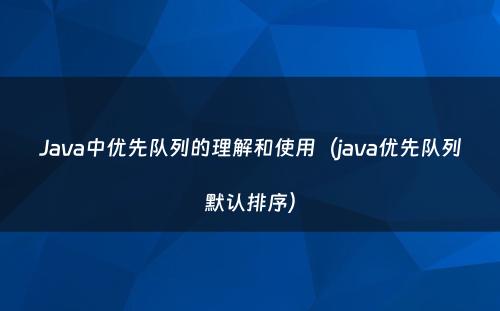网站首页 > java教程 正文
1 什么是优先队列(堆)
1.1 继承关系
首先看下Java中堆的继承关系,可以看出堆实现了队列的全部方法。
1.2 堆的数据结构
1.3 特征:
(1)二叉堆是一个完全二叉树

(2)根节点总是大于左右子节点(大顶堆),或者是小于左右子节点(小顶堆)。
1.4 常见方法
add()
//调用了offer方法
public boolean add(E e) {
return offer(e);
}
//判断输入元素是否为空,如果不为空
public boolean offer(E e) {
if (e == null)
throw new NullPointerException();
modCount++;
int i = size;
if (i >= queue.length)
//增加容量
grow(i + 1);
size = i + 1;
if (i == 0)
queue[0] = e;
else
//上浮方法--(小根堆)将小的元素进行上浮
siftUp(i, e);
return true;
}offer()
//判断输入元素是否为空,如果不为空
public boolean offer(E e) {
if (e == null)
throw new NullPointerException();
modCount++;
int i = size;
if (i >= queue.length)
//增加容量
grow(i + 1);
size = i + 1;
if (i == 0)
queue[0] = e;
else
//上浮方法--(小根堆)将小的元素进行上浮
siftUp(i, e);
return true;
}
//私有方法
/*
作用:在k位置插入项x,通过提升x到树的顶端,保持堆不变,直到它大于或等于它的父结点,
或者是根结点
*/
private void siftUp(int k, E x) {
if (comparator != null)
siftUpUsingComparator(k, x);
else
siftUpComparable(k, x);
}peek()
//弹出堆顶的元素
public E peek() {
return (size == 0) ? null : (E) queue[0];
}remove()
//先找出位置,再进行删除
public boolean remove(Object o) {
int i = indexOf(o);
if (i == -1)
return false;
else {
removeAt(i);
return true;
}
}contains()
//查看元素是否存在的本质就是看看有没有他的位置
public boolean contains(Object o) {
return indexOf(o) != -1;
}toArray()
public Object[] toArray() {
return Arrays.copyOf(queue, size);
}
//与上边的不同就是需要有一个泛型
public <T> T[] toArray(T[] a) {
final int size = this.size;
if (a.length < size)
//返回一个新的带泛型的数组
return (T[]) Arrays.copyOf(queue, size, a.getClass());
System.arraycopy(queue, 0, a, 0, size);
if (a.length > size)
a[size] = null;
return a;
}size()
public int size() {
return size;
}clear()
//遍历一次 全部置为null
public void clear() {
modCount++;
for (int i = 0; i < size; i++)
queue[i] = null;
size = 0;
}poll()
//返回并删除第一个元素
public E poll() {
if (size == 0)
return null;
int s = --size;
modCount++;
//取出堆顶元素
E result = (E) queue[0];
//取出最后一个元素
E x = (E) queue[s];
queue[s] = null;
if (s != 0)
//做下沉操作
siftDown(0, x);
return result;
}2 Java中堆的使用(小根堆为例)
2.1 堆排序
/**
* @author ymx
*/
public class TestPriorityQueue {
/**
* 声明一个堆
*/
public PriorityQueue<Integer> queue = new PriorityQueue();
/**
* 初始化数据
*
* @param items
*/
public void init(int[] items) {
for (int i = 0; i < items.length; i++) {
//将数据放入堆中
queue.add(items[i]);
}
}
/**
* 排序操作
*
* @return
*/
public int[] sort() {
int[] items = new int[queue.size()];
int i = 0;
while (queue.size() > 0) {
//弹出并删除堆顶元素
items[i] = queue.poll();
i++;
}
return items;
}
public static void main(String[] args) {
TestPriorityQueue test = new TestPriorityQueue();
test.init(new int[]{5, 6, 4, 3, 8, 9, 7, 1, 2});
int[] sort = test.sort();
System.out.print("排序结果:");
for (Integer i : sort) {
System.out.print(i + " ");
}
}
}运行结果:
2.2 进程调度
堆在操作系统的进程调度中也被广泛使用,比如依据优先级进行的进程调度等等,在这里就不做详解啦
猜你喜欢
- 2024-09-08 java队列之LinkedBlockingQueue和ConcurrentLinkedQueue
- 2024-09-08 Java阻塞队列中的异类,SynchronousQueue底层实现原理剖析
- 2024-09-08 100个Java工具类之61:队列类Queue
- 2024-09-08 阿里架构师浅析数据结构:队列在线程池等有限资源池中的应用
- 2024-09-08 【每日一学】Java数据结构探秘:队列与List的强大应用与性能优化
- 2024-09-08 使用Redis实现消息队列功能在Java中的应用
- 2024-09-08 『并发包入坑指北』之阻塞队列(阻塞队列poll方法)
- 2024-09-08 工作了这么久,你知道Java线程池容量应该设置多少么
- 2024-09-08 一文读懂,Java内置的延迟队列DelayQueue,原理及使用方法
- 2024-09-08 Java 消息队列的简单实现(java如何实现消息队列的监听)
欢迎 你 发表评论:
- 最近发表
- 标签列表
-
- java反编译工具 (77)
- java反射 (57)
- java接口 (61)
- java随机数 (63)
- java7下载 (59)
- java数据结构 (61)
- java 三目运算符 (65)
- java对象转map (63)
- Java继承 (69)
- java字符串替换 (60)
- 快速排序java (59)
- java并发编程 (58)
- java api文档 (60)
- centos安装java (57)
- java调用webservice接口 (61)
- java深拷贝 (61)
- 工厂模式java (59)
- java代理模式 (59)
- java.lang (57)
- java连接mysql数据库 (67)
- java重载 (68)
- java 循环语句 (66)
- java反序列化 (58)
- java时间函数 (60)
- java是值传递还是引用传递 (62)

本文暂时没有评论,来添加一个吧(●'◡'●)